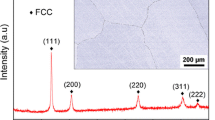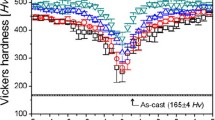Abstract
A CrMnFeCoNi high-entropy alloy was investigated by nanoindentation from room temperature to 400 °C in the nanocrystalline state and cast plus homogenized coarse-grained state. In the latter case a 〈100〉-orientated grain was selected by electron back scatter diffraction for nanoindentation. It was found that hardness decreases more strongly with increasing temperature than Young’s modulus, especially for the coarse-grained state. The modulus of the nanocrystalline state was slightly higher than that of the coarse-grained one. For the coarse-grained sample a strong thermally activated deformation behavior was found up to 100–150 °C, followed by a diminishing thermally activated contribution at higher testing temperatures. For the nanocrystalline state, different temperature dependent deformation mechanisms are proposed. At low temperatures, the governing processes appear to be similar to those in the coarse-grained sample, but with increasing temperature, dislocation-grain boundary interactions likely become more dominant. Finally, at 400 °C, decomposition of the nanocrystalline alloy causes a further reduction in thermal activation. This is rationalized by a reduction of the deformation controlling internal length scale by precipitate formation in conjunction with a diffusional contribution.





Similar content being viewed by others
References
J-W. Yeh, S-K. Chen, S-J. Lin, J-Y. Gan, T-S. Chin, T-T. Shun, C-H. Tsau, and S-Y. Chang: Nanostructured high-entropy alloys with multiple principal elements: Novel alloy design concepts and outcomes. Adv. Eng. Mater. 6, 299–303 (2004).
B. Cantor, I.T.H. Chang, P. Knight, and A.J.B. Vincent: Microstructural development in equiatomic multicomponent alloys. Mater. Sci. Eng., A 375–377, 213 (2004).
O.N. Senkov, G.B. Wilks, D.B. Miracle, C.P. Chuang, and P.K. Liaw: Refractory high-entropy alloys. Intermetallics 18, 1758 (2010).
Y. Zhang, T.T. Zuo, Z. Tang, M.C. Gao, K.A. Dahmen, P.K. Liaw, and Z.P. Lu: Microstructures and properties of high-entropy alloys. Prog. Mater. Sci. 61, 1 (2014).
E.J. Pickering and N.G. Jones: High-entropy alloys: A critical assessment of their founding principles and future prospects. Int. Mater. Rev. 6608, 1 (2016).
D.B. Miracle and O.N. Senkov: A critical review of high entropy alloys and related concepts. Acta Mater. 122, 448 (2017).
D. Miracle, B. Majumdar, K. Wertz, and S. Gorsse: New strategies and tests to accelerate discovery and development of multi-principal element structural alloys. Scr. Mater. 127, 195 (2017).
K.G. Pradeep, C.C. Tasan, M.J. Yao, Y. Deng, H. Springer, and D. Raabe: Non-equiatomic high entropy alloys: Approach towards rapid alloy screening and property-oriented design. Mater. Sci. Eng., A 648, 183 (2015).
V. Maier-Kiener, B. Schuh, E.P. George, H. Clemens, and A. Hohenwarter: Nanoindentation testing as a powerful screening tool for assessing phase stability of nanocrystalline high-entropy alloys. Mater. Des. 115, 479 (2017).
A. Gali and E.P. George: Tensile properties of high- and medium-entropy alloys. Intermetallics 39, 74 (2013).
B. Gludovatz, A. Hohenwarter, D. Catoor, E.H. Chang, E.P. George, and R.O. Ritchie: A fracture-resistant high-entropy alloy for cryogenic applications. Science 345, 1153 (2014).
G. Laplanche, P. Gadaud, O. Horst, F. Otto, G. Eggeler, and E.P. George: Temperature dependencies of the elastic moduli and thermal expansion coefficient of an equiatomic, single-phase CoCrFeMnNi high-entropy alloy. J. Alloys Compd. 623, 348 (2015).
A. Haglund, M. Koehler, D. Catoor, E.P. George, and V. Keppens: Polycrystalline elastic moduli of a high-entropy alloy at cryogenic temperatures. Intermetallics 58, 62 (2015).
B. Schuh, F. Mendez-Martin, B. Völker, E.P. George, H. Clemens, R. Pippan, and A. Hohenwarter: Mechanical properties, microstructure and thermal stability of a nanocrystalline CoCrFeMnNi high-entropy alloy after severe plastic deformation. Acta Mater. 96, 258 (2015).
F. Otto, A. Dlouhý, K.G. Pradeep, M. Kuběnová, D. Raabe, G. Eggeler, and E.P. George: Decomposition of the single-phase high-entropy alloy CrMnFeCoNi after prolonged anneals at intermediate temperatures. Acta Mater. 112, 40 (2016).
E.J. Pickering, R. Muñoz-Moreno, H.J. Stone, and N.G. Jones: Precipitation in the equiatomic high-entropy alloy CrMnFeCoNi. Scr. Mater. 113, 106 (2016).
M. Komarasamy, N. Kumar, R.S. Mishra, and P.K. Liaw: Anomalies in the deformation mechanism and kinetics of coarse-grained high entropy alloy. Mater. Sci. Eng., A 654, 256 (2016).
M. Vaidya, S. Trubel, B.S. Murty, G. Wilde, and S.V. Divinski: Ni tracer diffusion in CoCrFeNi and CoCrFeMnNi high entropy alloys. J. Alloys Compd. 688, 994 (2016).
L.R. Owen, E.J. Pickering, H.Y. Playford, H.J. Stone, M.G. Tucker, and N.G. Jones: An assessment of the lattice strain in the CrMnFeCoNi high-entropy alloy. Acta Mater. 122, 11 (2017).
N.L. Okamoto, S. Fujimoto, Y. Kambara, M. Kawamura, Z.M.T. Chen, H. Matsunoshita, K. Tanaka, H. Inui, and E.P. George: Size effect, critical resolved shear stress, stacking fault energy, and solid solution strengthening in the CrMnFeCoNi high-entropy alloy. Sci. Rep. 6, 35863 (2016).
F. Otto, A. Dlouhý, C. Somsen, H. Bei, G. Eggeler, and E.P. George: The influences of temperature and microstructure on the tensile properties of a CoCrFeMnNi high-entropy alloy. Acta Mater. 61, 5743 (2013).
E.D. Tabachnikova, A.V. Podolskiy, M.O. Laktionova, N.A. Bereznaia, M.A. Tikhonovsky, and A.S. Tortika: Mechanical properties of the CoCrFeNiMnVx high entropy alloys in temperature range 4.2–300 K. J. Alloys Compd. 698, 501 (2017).
Z. Wu, Y. Gao, and H. Bei: Thermal activation mechanisms and Labusch-type strengthening analysis for a family of high-entropy and equiatomic solid-solution alloys. Acta Mater. 120, 108 (2016).
S.I. Hong, J. Moon, S.K. Hong, and H.S. Kim: Thermally activated deformation and the rate controlling mechanism in CoCrFeMnNi high entropy alloy. Mater. Sci. Eng., A 682, 569 (2017).
I. Toda-Caraballo and P.E.J. Rivera-Díaz-Del-Castillo: Modelling solid solution hardening in high entropy alloys. Acta Mater. 85 (2015).
C. Varvenne, A. Luque, and W.A. Curtin: Theory of strengthening in fcc high entropy alloys. Acta Mater. 118 (2016).
Z. Wu, H. Bei, G.M. Pharr, and E.P. George: Temperature dependence of the mechanical properties of equiatomic solid solution alloys with face-centered cubic crystal structures. Acta Mater. 81, 428 (2014).
D-H. Lee, I-C. Choi, M-Y. Seok, J. He, Z. Lu, J-Y. Suh, M. Kawasaki, T.G. Langdon, and J-I. Jang: Nanomechanical behavior and structural stability of a nanocrystalline CoCrFeNiMn high-entropy alloy processed by high-pressure torsion. J. Mater. Res. 30, 2804 (2015).
D. Wu, J.S.C. Jang, and T.G. Nieh: Elastic and plastic deformations in a high entropy alloy investigated using a nanoindentation method. Intermetallics 68, 118 (2016).
D-H. Lee, M-Y. Seok, Y. Zhao, I-C. Choi, J. He, Z. Lu, J-Y. Suh, U. Ramamurty, M. Kawasaki, T.G. Langdon, and J-I. Jang: Spherical nanoindentation creep behavior of nanocrystalline and coarse-grained CoCrFeMnNi high-entropy alloys. Acta Mater. 109, 314 (2016).
R. Raghavan, C. Kirchlechner, B.N. Jaya, M. Feuerbacher, and G. Dehm: Mechanical size effects in a single crystalline equiatomic FeCrCoMnNi high entropy alloy. Scr. Mater. 129, 52 (2017).
H. Zhang, K.W. Siu, W. Liao, Q. Wang, Y. Yang, and Y. Lu: In situ mechanical characterization of CoCrCuFeNi high-entropy alloy micro/nano-pillars for their size-dependent mechanical behavior. Mater. Res. Express 3, 94002 (2016).
Y. Zou, S. Maiti, W. Steurer, and R. Spolenak: Size-dependent plasticity in an Nb25Mo25Ta25W25 refractory high-entropy alloy. Acta Mater. 65, 85 (2014).
Y.X. Ye, Z.P. Lu, and T.G. Nieh: Dislocation nucleation during nanoindentation in a body-centered cubic TiZrHfNb high-entropy alloy. Scr. Mater. 130, 64 (2017).
Q.F. He, J.F. Zeng, S. Wang, Y.F. Ye, C. Zhu, T.G. Nieh, Z.P. Lu, and Y. Yang: Delayed plasticity during nanoindentation of single-phase CoCrFeMnNi high-entropy alloy. Mater. Res. Lett. 3831, 1 (2016).
C. Zhu, Z.P. Lu, and T.G. Nieh: Incipient plasticity and dislocation nucleation of FeCoCrNiMn high-entropy alloy. Acta Mater. 61, 2993 (2013).
J.M. Wheeler and J. Michler: Invited article: Indenter materials for high temperature nanoindentation. Rev. Sci. Instrum. 84, 101301 (2013).
W.C. Oliver and G.M. Pharr: Improved technique for determining hardness and elastic modulus using load and displacement sensing indentation experiments. J. Mater. Res. 7, 1564 (1992).
J.M. Wheeler, D.E.J. Armstrong, W. Heinz, and R. Schwaiger: High temperature nanoindentation: The state of the art and future challenges. Curr. Opin. Solid State Mater. Sci. 19, 354 (2015).
V. Maier, K. Durst, J. Mueller, B. Backes, H.W. Höppel, and M. Göken: Nanoindentation strain-rate jump tests for determining the local strain-rate sensitivity in nanocrystalline Ni and ultrafine-grained Al. J. Mater. Res. 26, 1421 (2011).
Q. Wei, S. Cheng, K.T. Ramesh, and E. Ma: Effect of nanocrystalline and ultrafine grain sizes on the strain rate sensitivity and activation volume: Fcc versus bcc metals. Mater. Sci. Eng., A 381, 71 (2004).
K. Durst and V. Maier: Dynamic nanoindentation testing for studying thermally activated processes from single to nanocrystalline metals. Curr. Opin. Solid State Mater. Sci. 19, 340 (2015).
V. Maier, C. Schunk, M. Göken, and K. Durst: Microstructure-dependent deformation behaviour of bcc-metals—Indentation size effect and strain rate sensitivity. Philos. Mag. 95, 1766 (2014).
J.J. Vlassak and W.D. Nix: Measuring the elastic properties of anisotropic materials by means of indentation experiments. J. Mech. Phys. Solids 42, 1223 (1994).
X. Huang, N. Hansen, and N. Tsuji: Hardening by annealing and softening by deformation in nanostructured metals. Science 312, 249 (2006).
T. Yu, N. Hansen, X. Huang, and A. Godfrey: Observation of a new mechanism balancing hardening and softening in metals. Mater. Res. Letters, 2, 160 (2014).
O. Renk, A. Hohenwarter, K. Eder, K.S. Kormout, J.M. Cairney, and R. Pippan: Increasing the strength of nanocrystalline steels by annealing: Is segregation necessary? Scr. Mater. 95, 27 (2015).
W.D. Nix and H. Gao: Indentation size effects in crystalline materials: A law for strain gradient plasticity. J. Mech. Phys. Solids 46, 411 (1998).
S. Van Petegem, J. Zimmermann, and H. Van Swygenhoven: Yield point phenomenon during strain rate change in nanocrystalline Ni–Fe. Scr. Mater. 65, 217 (2011).
M.A. Meyers, A. Mishra, and D.J. Benson: Mechanical properties of nanocrystalline materials. Prog. Mater. Sci. 51, 427 (2006).
A. Seeger: Temperature and strain-rate dependence of the flow stress of body-centered cubic metals: A theory based on kink–kink interactions. Z. Met. Res. Adv. Tech. 72, 369 (1981).
H. Conrad: Plastic deformation kinetics in nanocrystalline fcc metals based on the pile-up of dislocations. Nanotechnology 18, 1 (2007).
Y.J. Li, J. Mueller, H.W. Höppel, M. Göken, and W. Blum: Deformation kinetics of nanocrystalline nickel. Acta Mater. 55, 5708 (2007).
G. Mohanty, J.M. Wheeler, R. Raghavan, J. Wehrs, M. Hasegawa, S. Mischler, L. Philippe, and J. Michler: Elevated temperature, strain rate jump microcompression of nanocrystalline nickel. Philos. Mag. 95, 1878 (2015).
H.W. Höppel, J. May, P. Eisenlohr, and M. Göken: Strain-rate sensitivity of ultrafine-grained materials. Z. Metallkd. 96 (6), 566 (2005).
Q. Wei: Strain rate effects in the ultrafine grain and nanocrystalline regimes-influence on some constitutive responses. J. Mater. Sci. 42, 1709 (2007).
M. Kreuzeder, M-D. Abad, M-M. Primorac, P. Hosemann, V. Maier, and D. Kiener: Fabrication and thermo-mechanical behavior of ultra-fine porous copper. J. Mater. Sci. 50, 634 (2015).
D. Wu, X.L. Wang, and T.G. Nieh: Variation of strain rate sensitivity with grain size in Cr and other body-centred cubic metals. J. Phys. D: Appl. Phys. 47, 175303 (2014).
A. Leitner, V. Maier-Kiener, J. Jeong, M.D. Abad, P. Hosemann, S.H. Oh, and D. Kiener: Interface dominated mechanical properties of ultra-fine grained and nanoporous Au at elevated temperatures. Acta Mater. 121, 104 (2016).
ACKNOWLEDGMENTS
Funding by the Austrian Science Fund (FWF) in the framework of Research Project P26729-N19 is acknowledged (B.S. & A.H.). Further financial support by the Austrian Federal Government (837900) within the framework of the COMET Funding Program (MPPE, A7.19) is highly appreciated (V.M-K.). E.P.G. is sponsored by the U.S. Department of Energy, Office of Science, Basic Energy Sciences, Materials Sciences and Engineering Division.
Author information
Authors and Affiliations
Corresponding author
Rights and permissions
About this article
Cite this article
Maier-Kiener, V., Schuh, B., George, E.P. et al. Insights into the deformation behavior of the CrMnFeCoNi high-entropy alloy revealed by elevated temperature nanoindentation. Journal of Materials Research 32, 2658–2667 (2017). https://doi.org/10.1557/jmr.2017.260
Received:
Accepted:
Published:
Issue Date:
DOI: https://doi.org/10.1557/jmr.2017.260




